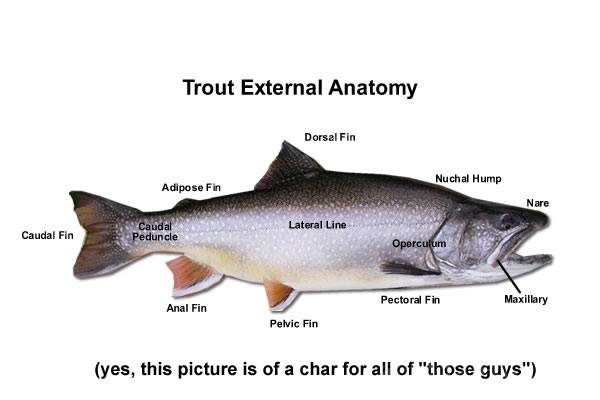Trout Anatomy
The more I fish for trout the more I want to learn about them. I have read every trout book imaginable, visited every trout website, read every trout magazine article and still learn more every year. One of the things that I love about trophy trout fishing is that no matter how long you have been after them… they still continue to challenge. Even the guys who have been chasing big trout their entire lives cannot put big fish in the boat every trip. You may pick up a solid pattern here and there but even those can fall apart from one year to the next.
So, that being said, I am going to write a series of article about the science of trout. This will include the anatomy of trout, the internal workings of a trout, forage items, etc. I may write some articles about each major trout species and what makes them unique. It is amazing that an animal with a brain the size of a pea can outsmart us time and time again. They are awesome creatures, perfectly suited to their environment.
A very interesting job that I was invited to work on while employed by the Oregon Department of Fish and Game was a snorkel survey for juvenile bull trout on a tributary to the McKenzie River. I was able to get up close and personal to these beautiful fish and watch them navigate in heavy current. They are able to use subtle movements from various fins to maintain their position in the swirling currents of this very high gradient river. I felt so clumsy in my SCUBA fins and dry suit trying to just keep from getting swept down river into the rapids.
What really blew my mind while doing these surveys was how well the juvenile bull trout camouflage to their surroundings. If you check out a young bull trout you wouldn’t think pink spots and greenish body color would camouflage well… but when looking directly down onto their backs as we drifted over them they simply vanished into the surrounding rocks.
Ok, on to the anatomy. I am going to cover some basics external anatomic features of a trout. These are terms that you may run into while reading articles, books or in discussions with other anglers. In future articles I will go into more detail regarding some of the internal anatomy of trout and how it applies to us as anglers.

Common Trout External Anatomy Terms
Adipose Fin – Small top fin towards the back of the fish that is very important to us as trout anglers. First, because it is one of the unique characteristics of the trout family and secondly because it is a great fin to clip for fishery managers to track data.
Anal Fin – Lower single fin near the back of the fish. Very old fish may exhibit unusually long anal fins.
Caudal Fin – Tail fin. May exhibit damage due to spawning habits or landing net mesh.
Caudal Peduncle – Sometimes called the “wrist” of the tail this is the thin area directly in front of the caudal fin. It is a good place to hold/control a large trout while removing a hook.
Dorsal Fin – Top fin… think shark fin. This fin can lay down at high speeds and can exhibit some of the coloration of the trout, depending on species.
Kype – Hook in the jaw of trout usually more pronounced during the spawning season.
Lateral Line – Line of sensory organs on each side of the trout that allow trout to feel and “hear” vibrations.
Maxillary – Bone extending from top of mouth. This can be missing from hook scar from a poor release and is occasionally clipped as a mark by fishery managers.
Nare – Nostrils.
Nuchal Hump – A “pronounced forehead” hump sometimes associated with males during spawning season.
Operculum – Commonly called the “gill plate” this is actually a bone that covers the very fragile gill filaments.
Pectoral Fin – Paired fins that are near the gills used heavily by the trout to navigate as they swim. They can perform a variety of movements.
Pelvic Fin – Can also be called the ventral fins. Paired fins that are located on the bottom, front of the trout. These are sometimes clipped to mark the trout.
This is a VERY basic intro. I had to write entire papers on some of these features while in college so there is much room for elaboration. In future articles I may go into more detail for some of the more important features that could potentially affect how the trout feed and live and may give us insight on how to catch them.
Mark Knoch




